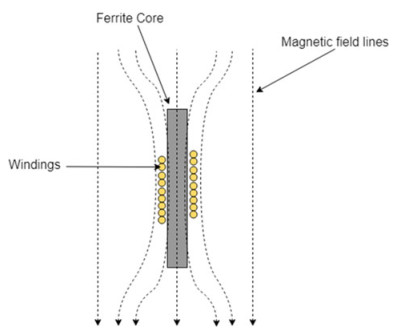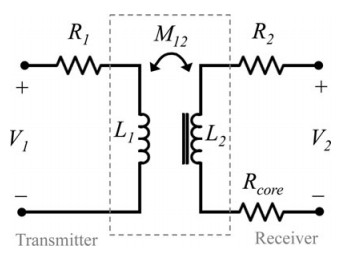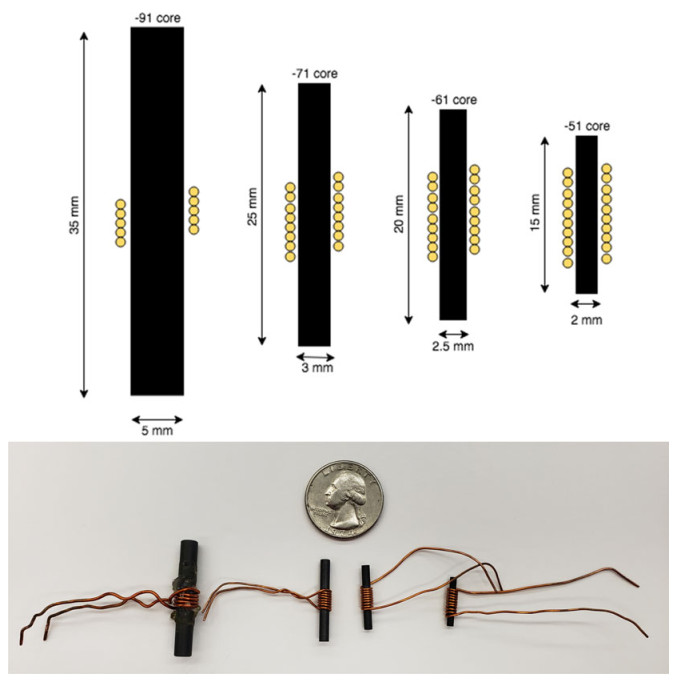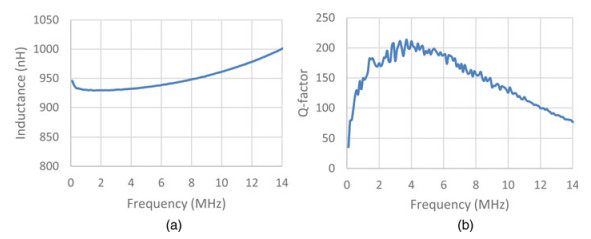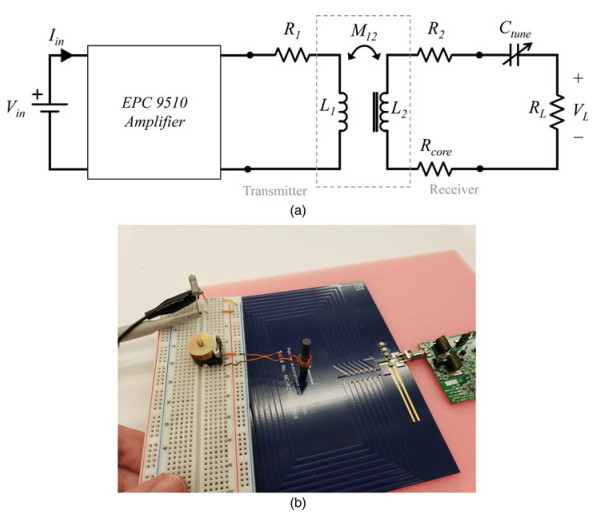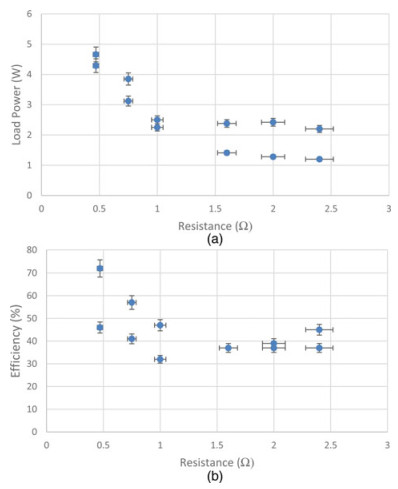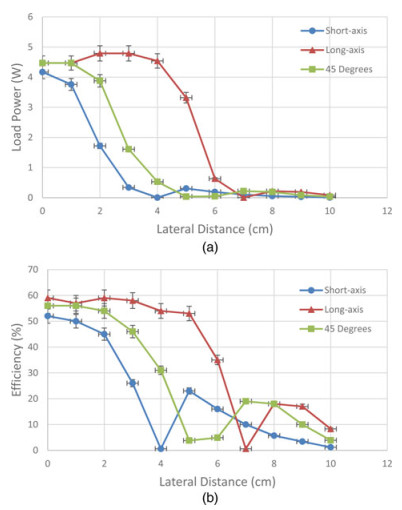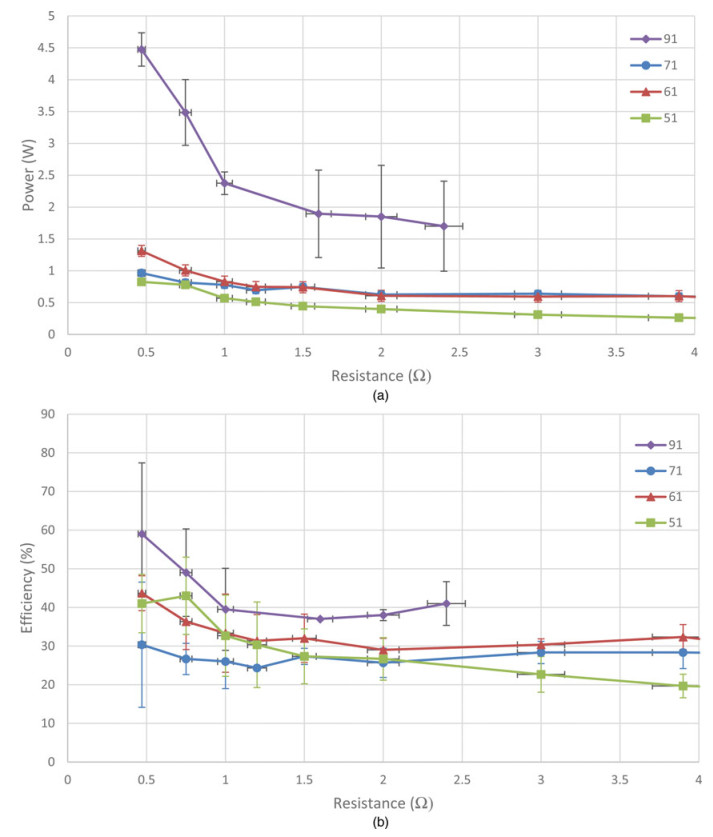Experimental demonstration of multi-watt wireless power transmission to ferrite-core receivers at 6.78 MHz
-
Department of Electrical and Computer Engineering, University of Florida, Gainesville, FL, USA
Fund Project:
This work was supported in part by the NSF I/UCRC on Multi-functional Integrated System Technology (MIST) Center (NSF Grant IIP-1439644) as well as internal support from the University of Florida Office of Technology Licensing
More Information
-
Author Bio:
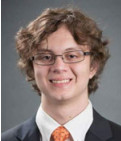 Stasiu T. Chyczewski
Stasiu T. Chyczewski is currently working on his B.S. in Electrical Engineering at the University of Florida (2020). His current research interests include wireless power systems.
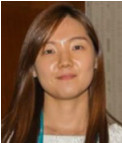 Seahee Hwangbo
Seahee Hwangbo received her B.S. degree from Gangneung-Wonju National University, Gangneung-si, Republic of Korea, in 2012, and is currently pursuing her Ph.D. degree in Electrical and Computer Engineering at the University of Florida, Gainesville, FL, USA. Her current research interests include micro/nanofabrication, RF MEMS, RF/Microwave passive components, 5G/millimeter-wave (mm-wave) antennas for wireless chip-to-chip communications in 3D-System in Packaging (3D-SiP), and low RF loss conductors for 28 GHz 5 G applications. She won second place in 2017 International Microwave Symposium (IMS) Student Paper Competition and the IEEE Antennas and Propagation Society (AP-S) Doctoral Research Award in 2016.
 Yong Kyu Yoon
Yong Kyu Yoon received his Ph.D. degree in Electrical and Computer Engineering from the Georgia Institute of Technology, Atlanta, GA, USA in 2004. He is currently an Associate Professor of the Department of Electrical and Computer Engineering at the University of Florida, Gainesville, Florida, USA. He received the NSF Early Career Development Award (CAREER) and SUNY Young Investigator Award. He has more than 180 peer-reviewed publications. He is a member of IEEE society. His research interests include microelectromechanical systems, nanofabrication, and energy storage devices; metamaterials for RF/microwave applications; micromachined millimeter wave/terahertz antennas and waveguides; wireless telemetry systems for biomedical applications; and ferroelectric materials for memory and tunable RF devices.
 David P. Arnold
David P. Arnold received dual B.S. (1999) and M.S. degrees (2001) from the University of Florida and the Ph.D. degree in Electrical and Computer Engineering from Georgia Tech (2004). He is currently the George Kirkland Engineering Leadership Professor in the Department of Electrical and Computer Engineering, Deputy Director of the NSF Multi-functional Integrated System Technology (MIST) Center, and Director of the Interdisciplinary Microsystems Group at the University of Florida. His research focuses on micro/nanostructured magnetic materials, magnetic microsystems, electromechanical transducers, and miniaturized power/energy systems. He has co-authored over 170 refereed journal and conference publications, and holds 16 US patents
-
Corresponding author:
D. P. Arnold Email: darnold@ufl.edu
-
Abstract
This article experimentally explores the use of ferrite cores to miniaturize the receivers used for inductive wireless power transmission. A variety of receivers were designed and fabricated using cylindrical ferrite cores, ranging in total size from 47 to 687 mm3. The receivers were tested with a commercially available transmitter operating under the Rezence (Air Fuel Alliance) standard at 6.78 MHz. Experiments measured performance of the receivers in terms of their maximum power draw and efficiency as functions of the receiver load and transmission distance. Experimental results showed that ferrite-core receivers could draw multiple watts of power with end-to-end efficiencies in excess of 50%. While the efficiencies are less than a commercially planar coil receiver, the ferrite-core receivers offer a > 50% reduction in mass and > 90% reduction in footprint. As a result, the receiver power densities reach up to 17.6 W/cm3, which is a 25× improvement over previously reported work. This effort confirms the viability of ferrite-core receivers for size- and weight-constrained applications.
-
About this article
Cite this article
Chyczewski S, Hwangbo S, Yoon Y, Arnold D P. 2019. Experimental demonstration of multi-watt wireless power transmission to ferrite-core receivers at 6.78 MHz. Wireless Power Transfer 6(1): 17-25 doi: 10.1017/wpt.2018.6
|
Chyczewski S, Hwangbo S, Yoon Y, Arnold D P. 2019. Experimental demonstration of multi-watt wireless power transmission to ferrite-core receivers at 6.78 MHz. Wireless Power Transfer 6(1): 17-25 doi: 10.1017/wpt.2018.6
|









 Stasiu T. Chyczewski is currently working on his B.S. in Electrical Engineering at the University of Florida (2020). His current research interests include wireless power systems.
Stasiu T. Chyczewski is currently working on his B.S. in Electrical Engineering at the University of Florida (2020). His current research interests include wireless power systems.  Seahee Hwangbo received her B.S. degree from Gangneung-Wonju National University, Gangneung-si, Republic of Korea, in 2012, and is currently pursuing her Ph.D. degree in Electrical and Computer Engineering at the University of Florida, Gainesville, FL, USA. Her current research interests include micro/nanofabrication, RF MEMS, RF/Microwave passive components, 5G/millimeter-wave (mm-wave) antennas for wireless chip-to-chip communications in 3D-System in Packaging (3D-SiP), and low RF loss conductors for 28 GHz 5 G applications. She won second place in 2017 International Microwave Symposium (IMS) Student Paper Competition and the IEEE Antennas and Propagation Society (AP-S) Doctoral Research Award in 2016.
Seahee Hwangbo received her B.S. degree from Gangneung-Wonju National University, Gangneung-si, Republic of Korea, in 2012, and is currently pursuing her Ph.D. degree in Electrical and Computer Engineering at the University of Florida, Gainesville, FL, USA. Her current research interests include micro/nanofabrication, RF MEMS, RF/Microwave passive components, 5G/millimeter-wave (mm-wave) antennas for wireless chip-to-chip communications in 3D-System in Packaging (3D-SiP), and low RF loss conductors for 28 GHz 5 G applications. She won second place in 2017 International Microwave Symposium (IMS) Student Paper Competition and the IEEE Antennas and Propagation Society (AP-S) Doctoral Research Award in 2016.  Yong Kyu Yoon received his Ph.D. degree in Electrical and Computer Engineering from the Georgia Institute of Technology, Atlanta, GA, USA in 2004. He is currently an Associate Professor of the Department of Electrical and Computer Engineering at the University of Florida, Gainesville, Florida, USA. He received the NSF Early Career Development Award (CAREER) and SUNY Young Investigator Award. He has more than 180 peer-reviewed publications. He is a member of IEEE society. His research interests include microelectromechanical systems, nanofabrication, and energy storage devices; metamaterials for RF/microwave applications; micromachined millimeter wave/terahertz antennas and waveguides; wireless telemetry systems for biomedical applications; and ferroelectric materials for memory and tunable RF devices.
Yong Kyu Yoon received his Ph.D. degree in Electrical and Computer Engineering from the Georgia Institute of Technology, Atlanta, GA, USA in 2004. He is currently an Associate Professor of the Department of Electrical and Computer Engineering at the University of Florida, Gainesville, Florida, USA. He received the NSF Early Career Development Award (CAREER) and SUNY Young Investigator Award. He has more than 180 peer-reviewed publications. He is a member of IEEE society. His research interests include microelectromechanical systems, nanofabrication, and energy storage devices; metamaterials for RF/microwave applications; micromachined millimeter wave/terahertz antennas and waveguides; wireless telemetry systems for biomedical applications; and ferroelectric materials for memory and tunable RF devices.  David P. Arnold received dual B.S. (1999) and M.S. degrees (2001) from the University of Florida and the Ph.D. degree in Electrical and Computer Engineering from Georgia Tech (2004). He is currently the George Kirkland Engineering Leadership Professor in the Department of Electrical and Computer Engineering, Deputy Director of the NSF Multi-functional Integrated System Technology (MIST) Center, and Director of the Interdisciplinary Microsystems Group at the University of Florida. His research focuses on micro/nanostructured magnetic materials, magnetic microsystems, electromechanical transducers, and miniaturized power/energy systems. He has co-authored over 170 refereed journal and conference publications, and holds 16 US patents
David P. Arnold received dual B.S. (1999) and M.S. degrees (2001) from the University of Florida and the Ph.D. degree in Electrical and Computer Engineering from Georgia Tech (2004). He is currently the George Kirkland Engineering Leadership Professor in the Department of Electrical and Computer Engineering, Deputy Director of the NSF Multi-functional Integrated System Technology (MIST) Center, and Director of the Interdisciplinary Microsystems Group at the University of Florida. His research focuses on micro/nanostructured magnetic materials, magnetic microsystems, electromechanical transducers, and miniaturized power/energy systems. He has co-authored over 170 refereed journal and conference publications, and holds 16 US patents 


